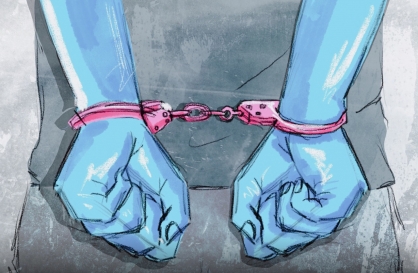
South Korean and US intelligence are closely monitoring for signs of North Korea’s next missile test, the military said Monday in response to satellite images showing preparations to launch a submarine-launched ballistic missile for the second time since October.
The images -- made public last week by 38 North, which monitors North Korea -- showed activity involving a mobile crane and a submerged barge at Sinpo, a port city along the east coast where North Korea runs a major submarine shipyard.
Pyongyang used a small submarine to carry out an SLBM test last month, but Seoul called it an early-stage weapon, saying it could easily be taken down and that North Korea still did not have the resources to stage a full SLBM strike from a submarine big enough to fire multiple SLBMs.
The South -- which is the only non-nuclear state to have demonstrated an SLBM launch, using a 3,000-ton submarine -- believes it would take at least five years for the North to match its SLBM technology, though Pyongyang has dismissed Seoul’s missile capabilities, describing it as primitive.
Meanwhile, South Korea and the US kicked off an air exercise, mobilizing their key fighter jets. The allies used to hold larger, full-scale drills, but have cut back on them since 2018, when they and North Korea agreed at separate one-on-one meetings to dial back hostilities.
The Air Force declined to discuss details of the five-day exercise, including any plans to return to full-scale endeavors.
Despite the scaled-down drills, Pyongyang has carried on with its weapons tests. North Korea now insists the allies suspend their drills altogether and roll out sanctions relief if they want to resume nuclear negotiations.
While the South and the US have yet to respond, the Moon Jae-in administration is proposing signing a declaration to formally end the 1950-53 Korean War, which halted with an armistice and not a peace treaty.
Moon, who is anxious to see a breakthrough in ties before he leaves office in May next year, believes the gesture of goodwill would be a way to rebuild the trust necessary to reopen talks. The US disagrees, with its national security chief openly favoring an alternative.
The images -- made public last week by 38 North, which monitors North Korea -- showed activity involving a mobile crane and a submerged barge at Sinpo, a port city along the east coast where North Korea runs a major submarine shipyard.
Pyongyang used a small submarine to carry out an SLBM test last month, but Seoul called it an early-stage weapon, saying it could easily be taken down and that North Korea still did not have the resources to stage a full SLBM strike from a submarine big enough to fire multiple SLBMs.
The South -- which is the only non-nuclear state to have demonstrated an SLBM launch, using a 3,000-ton submarine -- believes it would take at least five years for the North to match its SLBM technology, though Pyongyang has dismissed Seoul’s missile capabilities, describing it as primitive.
Meanwhile, South Korea and the US kicked off an air exercise, mobilizing their key fighter jets. The allies used to hold larger, full-scale drills, but have cut back on them since 2018, when they and North Korea agreed at separate one-on-one meetings to dial back hostilities.
The Air Force declined to discuss details of the five-day exercise, including any plans to return to full-scale endeavors.
Despite the scaled-down drills, Pyongyang has carried on with its weapons tests. North Korea now insists the allies suspend their drills altogether and roll out sanctions relief if they want to resume nuclear negotiations.
While the South and the US have yet to respond, the Moon Jae-in administration is proposing signing a declaration to formally end the 1950-53 Korean War, which halted with an armistice and not a peace treaty.
Moon, who is anxious to see a breakthrough in ties before he leaves office in May next year, believes the gesture of goodwill would be a way to rebuild the trust necessary to reopen talks. The US disagrees, with its national security chief openly favoring an alternative.





![[KH Explains] No more 'Michael' at Kakao Games](http://res.heraldm.com/phpwas/restmb_idxmake.php?idx=644&simg=/content/image/2024/04/28/20240428050183_0.jpg&u=20240428180321)













![[Herald Interview] Mistakes turn into blessings in street performance, director says](http://res.heraldm.com/phpwas/restmb_idxmake.php?idx=652&simg=/content/image/2024/04/28/20240428050150_0.jpg&u=20240428174656)
